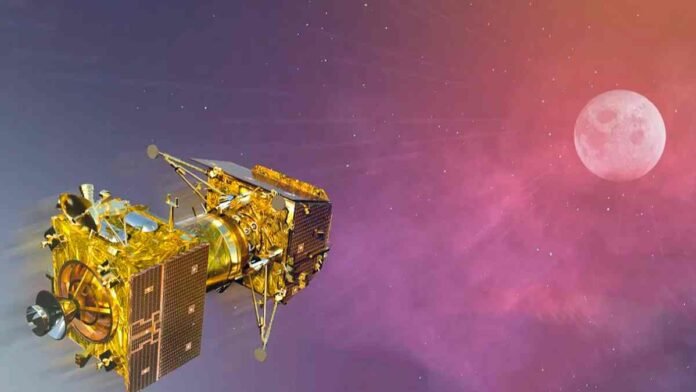The Geosynchronous Satellite Launch Vehicle (GSLV) Mark-III, ISRO’s biggest rocket, launched the Chandrayaan-3 propulsion module and lander into an elliptical orbit around Earth in 15 minutes.
ISRO will use the onboard propulsion engine to raise the orbit five to six times in two weeks.
The module will spiral outward in longer ellipses with each propulsion system burn.
The propulsion module’s speed will continuously grow until it reaches the escape velocity needed to escape Earth’s gravity and enter a Lunar Transfer Trajectory (LTT) and go for the moon.
Chandrayaan-3 will enter translunar injection on August 1. Three weeks later, on August 23, the landing is expected.
The lander and rover will touchdown on the moon 40 days after launch and multiple orbital maneuvers.
Given the Earth-Moon distance, the trip time may seem acceptable, yet prior missions have done it faster.
China’s 2010 Chang’e 2 mission and its 2013 follow-up, Chang’e 3, took four days to reach the Moon.
Luna-1, the first unmanned mission to reach the Moon, took 36 hours.
Columbia, carrying three men on Apollo-11, reaches the Moon in four days.
Why is Chandrayaan-3 taking weeks to approach the cratered sphere?
ISRO lacks a rocket strong enough to launch Chandrayaan-3 directly to the Moon.
Apollo missions employed Translunar Injection (TLI), a straight route. Apollo was launched initially using the Saturn V launch vehicle.
A massive engine fire sent the spaceship toward the Moon. The Saturn rocket’s third stage’s six-minute burn slingshotted the spacecraft to the LTT.
Apollo missions reached the Moon in days using this straight method.
The Apollo 11 lunar orbital plan.
The Apollo 11 lunar orbital plan.
Chandrayaan-3’s trajectory is different.
As said, the mission will employ Earth orbits and engine burns to gradually boost the spacecraft’s speed and position it for a lunar insertion.
The spacecraft will enter an initial Earth orbit and then fire engines at certain periods to go to a trajectory that overlaps the Moon’s orbit. The spaceship will enter lunar orbit after another engine fire.
Chandrayaan-3 profile.
ISRO’s multi-step Chandrayaan and Mangalyaan missions take longer but employ less powerful launch vehicles.
The Apollo Saturn V had more power and payload than the GSLV Mk-III. To optimize the mission within launch vehicle limits, a more progressive trajectory was chosen.
ISRO will circumvent restrictions using Earth and Moon gravity.
The module will be at its fastest when it travels through the point in its elliptical orbit closest to Earth. It’s the perigee.
The module will be furthest from Earth and slowest during the apogee, opposite this location. The Earth’s gravitational pull changes the orbit’s speed.
The module’s gravitational pull and speed increase as it approaches Earth. When the module reaches perigee, its onboard motor activates, boosting its speed and propelling it into a higher, more extended orbit.
The module will spiral outward in longer ellipses with each propulsion system burn.
The module eventually reaches escape velocity to escape Earth’s gravity. The module’s orbit will stretch, letting it go toward the moon.
The Chandrayaan-3 module’s LTT entrance is timed to match the moon’s orbit. This scheduling guarantees that the module approaches the moon’s orbit while it is there.
At this point, the onboard propulsion system performs a precise maneuver. Lunar orbit insertion slows the module.
The moon’s gravity can draw the module into a stable lunar orbit. The spacecraft’s lunar insertion was successful.
After leaving Earth’s gravity, the module will circle the moon elliptically.
The module will be gradually lowered to a 100 kilometer circular orbit around the moon. The propulsion module will separate from the lander, which will continue to the moon.
Chandrayaan-3 will become the first mission to soft-land near the lunar south pole on August 23 if everything goes well.
Conclusion
ISRO’s largest rocket, the GSLV Mark-III, has launched the Chandrayaan-3 propulsion module and lander into an elliptical orbit around Earth in 15 minutes. The module will spiral outward in longer ellipses with each propulsion system burn, increasing its speed until it reaches escape velocity. The mission will enter translunar injection on August 1, and the lander and rover will touchdown on the moon 40 days after launch. The trip time may seem acceptable, but prior missions have done it faster. The Apollo 11 lunar orbital plan uses Earth orbits and engine burns to gradually boost the spacecraft’s speed and position it for a lunar insertion.
The module will be at its fastest when traveling through the perigee, the point in its elliptical orbit closest to Earth. The onboard propulsion system performs a precise maneuver, and the lunar orbit insertion is successful. The module will circle the moon elliptically and be gradually lowered to a 100-kilometer circular orbit around the moon. If everything goes well, Chandrayaan-3 will become the first mission to soft-land near the lunar south pole on August 23.



